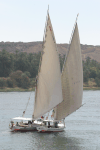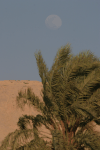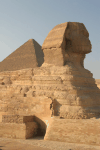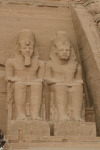The Ancient Egyptians had a large set of Gods and Goddesses. Their deities were pretty much like people, they were born, they got married, have children, fought each other, and died. They needed food and shelter, had feast, and got drunk, just like people. The Egyptians had a large set of stories about their Gods. Unfortunately (for us ![]() ) these stories changed with time. One Goddess could be the mother of one God for a while, later she was considered his wife, and maybe even his daughter. I am trying to recount a consistent story, but you need to be aware that this is only a snapshot of the real thing.
) these stories changed with time. One Goddess could be the mother of one God for a while, later she was considered his wife, and maybe even his daughter. I am trying to recount a consistent story, but you need to be aware that this is only a snapshot of the real thing.
All pictures are © Dr. Günther Eichhorn, unless otherwise noted.
The Universe started with nothing but the Water Chaos. It was called Nun. When the water subsided, the first land to appear was the Ben Ben stone. On it stood the Sun God Atum, who created himself. In some legends, Atum was replaced with Ra, who later merged with Amun to Amun Ra.
Atum performed auto fellatio and spat out Shu (the air) and Tephnut (the moisture). When Atum masturbated, the first word he exclaimed was deified into the God Hu, the Divine Utterance. Atum then drew blood from his penis and created the Goddess Sia. Sia was the personification of the Divine Knowledge/Omniscience of the Gods. Hu was the personification of the Divine Utterance, the Voice of the Gods. Heka, the personification of the Divine Power, joined them in a divine Triad.
Shu and Tephnut had two children, Geb (the earth) and Nut (the sky). Nut lay eternally, having sex with Geb. But Shu, their father, later separated them and lifted her up to form the sky as a canopy over Geb. It is said that if Nut every returns to that first position, chaos would reign.
After Geb and Nut were born, mankind was created from the tears of Atum.
Geb and Nut had four children. They were Osiris, Isis, Seth, and Nephtys. Osiris took Isis as his wife, and Seth took Nephtys.
Osiris was the King of the Earth and Isis was his Queen. He was a good King and ruled over the Earth for many years. However, his brother Seth was jealous of Osiris. He became more and more jealous, eventually decided to kill Osiris and take his place. He built a box (sometimes called a coffin) and inscribed it with powerful magic that would hold anyone, man or God, who entered the box. Seth then brought the box to a big feast of the Gods. He waited till Osiris was drunk and then challenged him to a contest of strength. Each of them would enter the box and attempt to break out with pure strength. Osiris was drunk and believed he could break out of this box, so he entered the box. Seth sealed the box with molten lead and Osiris was held inside by the powerful magic. Seth threw the box in the Nile and set it adrift. Seth then claimed the throne and Isis as his Queen. None of the other Gods dared to oppose him, since he had killed Osiris.
Seth was a bad King, cruel, uncaring, and unjust. War divided Egypt and all was lawless while Seth ruled.
Only Isis was unafraid of Seth. She searched all of the Nile for the coffin with Osiris. Finally she found it, lodged in a Tamarisk bush. The bush had grown into a mighty tree because of the power of Osiris, even though Osiris was dead. Isis brought the coffin back and placed it in the House of the Gods. Isis asked Thoth for help, and they tried to revive Osiris. Isis and Thoth created the Ritual of Life. But Seth discovered them and stole the body. He cut it into 14 pieces and scattered the pieces throughout Egypt. But Isis persisted and searched for all the pieces. She found 13 pieces, she only missed his Manhood. She made a prosthesis for his Manhood and put the body of Osiris together. Thoth went to Anubis, the Lord of the Dead. Anubis sewed the pieces together and embalmed Osiris and wrapped him in linen. The linen was woven by Isis and Nephtys and protected the body of Osiris from decay. Anubis then performed the Ritual of Life and revived Osiris. But Osiris had been dead, and nobody, not even a God, can stay in the realm of the Living after being dead. He went to the Land of the Dead. Anubis yielded the throne there, and Osiris became the Lord of the Dead.
Since Isis and Osiris were now separated, the Priests would once per year put the statue of Isis from the Isis temple and the statue of Osiris from his temple each on a sacred boat and join the two for a day on the Nile. After that, the statues were brought back to their respective temples.
Meanwhile Seth continued his cruel rule. But Isis had become pregnant from putting Osiris back together, and gave birth to a son, which she called Horus. After Horus was born, Isis hid with her baby son in the marshes. But she still had to come out of the marshes to the villages for food. Seth found out where Isis was hiding. He disguised as a snake and went into the marshes to find Horus while Isis was getting food. He found Horus alone and bit him, poisoning the child. When Isis came back into the marshes, she found Horus very ill. She didn't know what was wrong with him and her magic didn't help. She brought Horus to the villagers and asked for their help. The villagers tried to help, but they couldn't heal Horus. Isis cried out for help. Nephtys, her sister, heard her and came to answer her cries. She told Isis to stop the Sun Boat of Ra to get Ra to help. Isis knew the secret name of Ra, and therefore had power over Ra. Isis cried so loud and with Magic, that the Sun Boat of Ra stooped. Ra sent Thoth to find out what happened. When Thoth heard, he consoled Isis and told her that Ra assured the safety of Horus and that the Sun Boat would stop till Horus was recovered. Thoth had brought Magic with him from the Sun Boat, and he worked this Magic and drove the poison from Horus' body and Horus recovered. Thoth then ordered the people of the marshes and the animals and the birds to watch over Horus to keep him safe. The life of Isis and Horus was harsh, but they stayed there till Horus was old enough to challenge Seth and avenge his father.
When Horus was ready, his mother Isis gave him great Magic to use against Seth, and Thoth gave him a magic knife. Horus sought Seth and challenged him for the throne. They fought for many days. Horus finally defeated Seth and castrated him, but would not kill him, lest he be just as bad a Seth. Seth however maintained his claim on the throne, while Horus also claimed the throne, as the son of Osiris. The Gods started to fight amongst themselves, as to who supported Horus and who supported Seth. But one of the Gods said that they have to end their struggle peacefully, or Ma'at, the balance of life, would be imbalanced further. They asked Neith for council. Neith, warlike but wise, told the Gods that Horus was the rightful heir to the throne. Horus cast Seth into Darkness, where he lives to this day, scheming to overthrow Horus.
Horus had four sons. They were all associated with embalming the dead. They were the genii Imsety, Hapy (not the Nile God Hapi), Duamutef, and Kebehsenuef.
Ancient Egypt originally was in two parts, Upper Egypt (the South), and Lower Egypt (the North). These were two separate regions, ruled by separate rulers. The two parts were eventually united by King Narmer, the founder of the 1st Dynasty and the first Pharaoh. The crown of the ruler of Upper Egypt was the Hedjet or White Crown, the crown of the ruler of Lower Egypt was the Deshret or Red Crown. The Pshent, or Double Crown was used by the Pharaohs after Upper and Lower Egypt were united. The two parts of Egypt had many separate symbols for the same concepts. For instance the Lotus was the plant of Upper Egypt, the Papyrus the plant of Lower Egypt. The Cobra was the symbol of protection for Lower Egypt, the Vulture the symbol for protection for Upper Egypt. They can often be seen wearing the respective crown.
For more on symbols in ancient Egypt see Egyptian Symbols, including the ancient Egyptian Calendar system.
The embalming process was very ritualized. The body was opened, and the organs removed, except for the heart. The heart was very important, it would later be weighed in front of Osiris against a feather, to see whether a person was good or bad. The organs were placed in the four Canopic Jars. The Canopic Jars were protected by a Genius and a Goddess each. The four major organs were associated with these Goddesses. The liver was associated with the Genius Imsety, the first son of Horus, who claimed protection from the Goddess Isis. This jar had a human head on the lid. The lungs were identified with the Genius Hapy, the second son of Horus and the Goddess Nephtys. This jar had the head of a baboon on the lid. The stomach was identified with the Genius Duamutef, third son of Horus and the Goddess Neith. This jar had the had of a jackal on the lid. Lastly, the intestines were associated with the Genius Kebehsenuef, fourth son of Horus, and the Goddess Sekhmet. This jar had the head of a hawk on the lid. The brain was removed from the head by being liquefied, drained through the nose and discarded. It was not considered an important organ by the Ancient Egyptians.
Once the the funeral proceeded and the mummy reached its destination, the Opening of the Mouth Ceremony was performed. This allowed the body to eat, breathe and talk again. It was used on statues as well as the dead, to animate the statue. The priest would use an adz or a knife to touch the lips and open them.
The judgment of the dead was done through the Weighing of the Heart Ceremony. Anubis, the guide and friend of the dead would lead the deceased to the weighing of the heart ceremony in the hall of Ma'at. The heart would be put on a scale and a feather on the other side of the scale. If the heart was heavier than the feather, the dead would be devoured by the monster Ammit. If the heart was lighter than the feather, the soul would go on to the Afterlife. The judgment was recorded by Thoth, the God of the scribes and the God of Wisdom.
Here are the links to the other pages on Egypt:






Page last updated on Thu Mar 18 14:58:04 2021 (Mountain Standard Time)
Page last updated on Wed Apr 24 15:18:07 2024 (Mountain Standard Time)
Ancient Egyptian Mythology on geichhorn.com